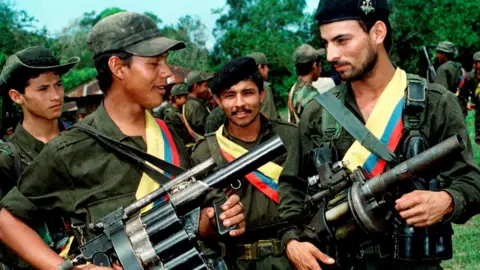Colombia Farc: 85 ex-rebels killed since peace deal
 RAUL ARBOLEDA/AFP/Getty
RAUL ARBOLEDA/AFP/GettyThe United Nations says 85 former Farc rebels have been killed in Colombia since the group signed a peace accord with the government two years ago.
Most of the murders were by illegal armed groups and drug gangs fighting over former Farc territories, UN chief Antonio Guterres said in a report.
Mr Guterres urged Colombian President Ivan Duque, a vocal critic of the peace deal, to do more to protect ex-rebels.
Colombia suffered 52 years of conflict until peace was reached in 2016.
The Farc, or Revolutionary Armed Forces of Colombia, is now a political party known as the Revolutionary Alternative Common Force with five seats in the Senate and five in the House of Representatives.
What does the UN say?
In the last three months alone, "14 ex-members of Farc were murdered", Secretary-General Guterres said in his quarterly report on the UN's mission to Colombia.
He also said he was "hugely" concerned that more than 400 social leaders and human rights activists had been killed in Colombia since 2016.
"Most of the murders were in zones abandoned by former Farc (fighters) and where there is limited state presence," the UN report said.
Since the peace accord, Colombia's weak state apparatus has been unable to take control of these isolated regions.
Instead, illegal armed groups have taken over and the security forces and president are increasingly coming under fire for not stemming the violence.
Who were the Farc?
The Farc was formed in 1964 with the stated intention of overthrowing the government and installing a Marxist regime.
 Reuters
ReutersTheir main founders were small farmers and land workers who had banded together to fight against the staggering levels of inequality in Colombia at the time.
After modest beginnings, the left-wing group rose to prominence through the 1980s and 1990s as its association with the drugs trade improved its financial standing. At its peak it was the largest and best-equipped guerrilla force in Latin America.
During half a century of conflict between Farc and the authorities, eight million people died, disappeared or were displaced.
The 2016 peace deal, reached after years of negotiations, resulted in some 7,000 ex-fighters laying down their weapons.